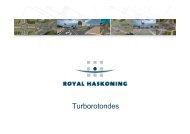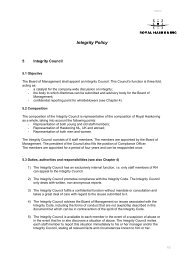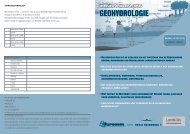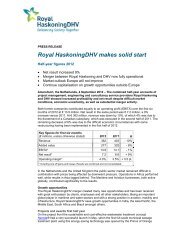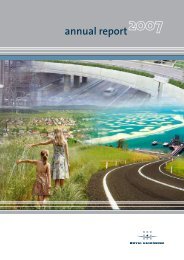Design of Deep Underground stations in soft soil ... - Royal Haskoning
Design of Deep Underground stations in soft soil ... - Royal Haskoning
Design of Deep Underground stations in soft soil ... - Royal Haskoning
You also want an ePaper? Increase the reach of your titles
YUMPU automatically turns print PDFs into web optimized ePapers that Google loves.
GEOLOGY<br />
The subsurface <strong>of</strong> Amsterdam is<br />
composed <strong>of</strong> sediments, up to depths<br />
vary<strong>in</strong>g between 800 to 1000 meters<br />
below ground level. The sediments<br />
(sands, silts, clays and peat) have<br />
orig<strong>in</strong>ated from mar<strong>in</strong>e-, glacial-,<br />
eolian- and river deposits. In the<br />
upper 350 meters <strong>of</strong> sediments two<br />
ma<strong>in</strong> geological important units are<br />
dist<strong>in</strong>guished, namely Holocene<br />
(10.000 years - present) and<br />
Pleistocene (10.000 - 2.5 million<br />
before present) deposits, see Figure 2<br />
for a general lithological pr<strong>of</strong>ile <strong>of</strong><br />
Amsterdam.<br />
The oldest and deepest Pleistocene<br />
deposits are mar<strong>in</strong>e clays and f<strong>in</strong>e- Figure 2: Geological cross section <strong>of</strong> Amsterdam<br />
gra<strong>in</strong>ed sands, which extend to a level<br />
<strong>of</strong> 250- 350 meter below groundlevel<br />
With the second last (Saalien) ice age sediments were deposited on top <strong>of</strong> these river deposits. The ice cap<br />
came near to the South <strong>of</strong> Amsterdam and created the Amsterdam Bas<strong>in</strong>. Dur<strong>in</strong>g this period ma<strong>in</strong>ly glacial<br />
and melt water deposits were formed with<strong>in</strong> the bas<strong>in</strong>. After melt<strong>in</strong>g <strong>of</strong> the ice cap the Amsterdam Bas<strong>in</strong> was<br />
flooded with the sea and partially filled with mar<strong>in</strong>e sands and clays (Eemclay). Dur<strong>in</strong>g the last ice age<br />
(100.000 - 10.000 years ago), the ice cap did not extend to the south <strong>of</strong> Amsterdam. In that period the<br />
Netherlands experienced a tundra climate. The Amsterdam Bas<strong>in</strong> was filled with ma<strong>in</strong>ly sand. These sand<br />
layers are very important to foundation practice <strong>in</strong> Amsterdam and marks also the end <strong>of</strong> the Pleistocene.<br />
Holocene deposits (ma<strong>in</strong>ly peats and clays) were ma<strong>in</strong>ly formed under the <strong>in</strong>fluence <strong>of</strong> the sea. The ris<strong>in</strong>g<br />
sea (0.5m per century) reached the present location <strong>of</strong> Amsterdam 7000 year ago. A transgression started due<br />
to lower<strong>in</strong>g <strong>of</strong> the sea level, 5000 years ago. Dur<strong>in</strong>g the Holocene a river connection existed to the sea. This<br />
river produced erosion channels <strong>in</strong> the Pleistocene sand deposits. In these channels, sometimes with widths<br />
over 100m, th<strong>in</strong> sand and (s<strong>of</strong>t) clay layers were deposited.<br />
SITE INVESTIGATION<br />
Along the route <strong>of</strong> the North/South l<strong>in</strong>e a comprehensive <strong>soil</strong> <strong>in</strong>vestigation has been made. This <strong>soil</strong><br />
<strong>in</strong>vestigation consisted <strong>of</strong> a total <strong>of</strong> 125 boreholes and about 400 CPT’s each up to depths <strong>of</strong> 70 meters. As<br />
well as these bor<strong>in</strong>gs and CPT’s, special tests like Cone Pressure Meters (CPM) were also carried out.<br />
In the laboratory the samples <strong>of</strong> the bor<strong>in</strong>gs were classified and tested. The laboratory tests were used ma<strong>in</strong>ly<br />
to determ<strong>in</strong>e the strength and stiffness parameters <strong>of</strong> the <strong>soil</strong>s, specially the Pleistocene Mar<strong>in</strong>e Eemclay. The<br />
reason to concentrate the site <strong>in</strong>vestigation to the Eemclay is that very little geotechnical <strong>in</strong>formation was<br />
available for this layer prior to the North/South l<strong>in</strong>e project. Also this will be the first time a construction<br />
(both the bored tunnel and the deep build<strong>in</strong>g pits for the <strong>stations</strong>) is made <strong>in</strong> this clay.<br />
Table 1: Global overview <strong>of</strong> laboratory tests<br />
Soil layer Classification Sieve analysis Atterberg Triaxial Oedometer<br />
limits tests test<br />
Holocene 405 35 45 50 19<br />
Pleistocene Sand 260 80 38<br />
Pleistocene Eemclay 360 170 170 96 135<br />
Other layers 685 265 165 49 37<br />
Total 1710 550 380 233 191



